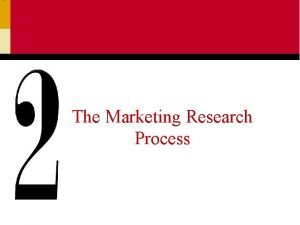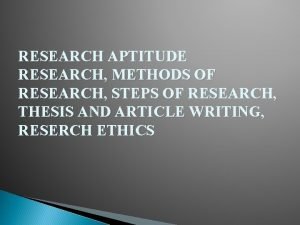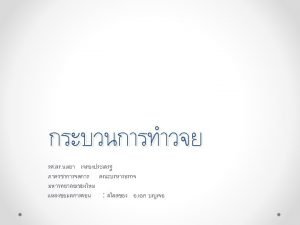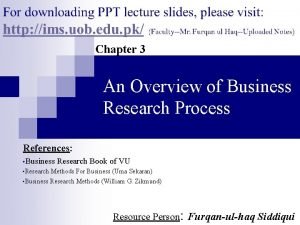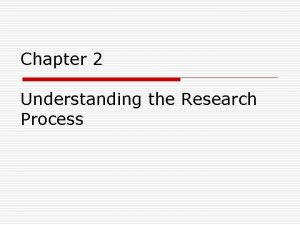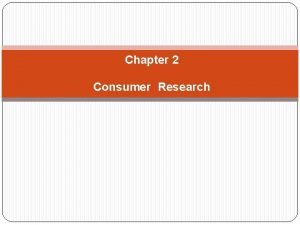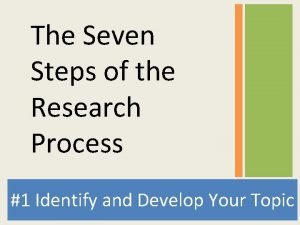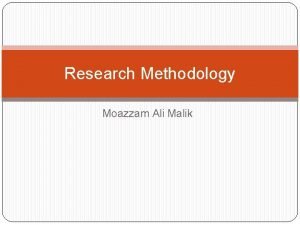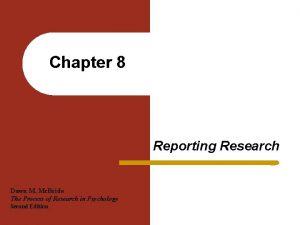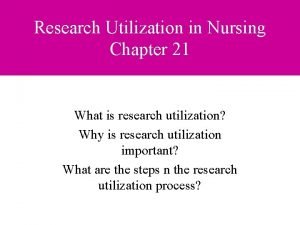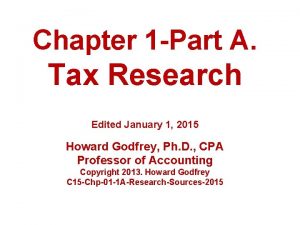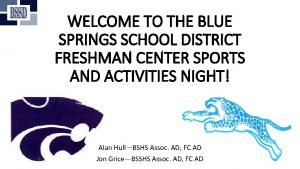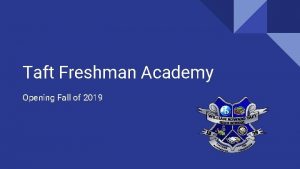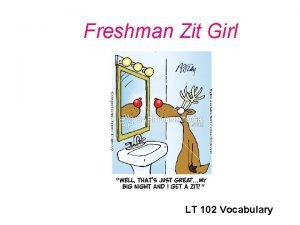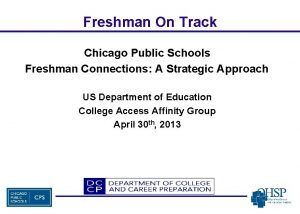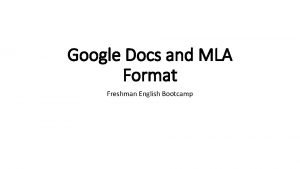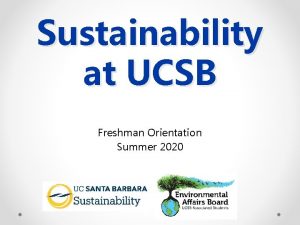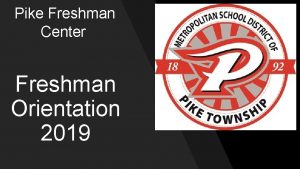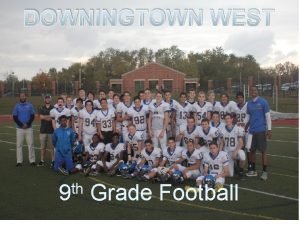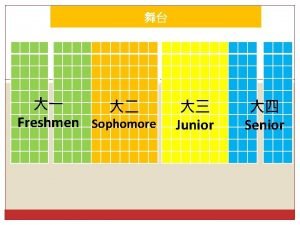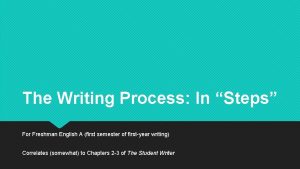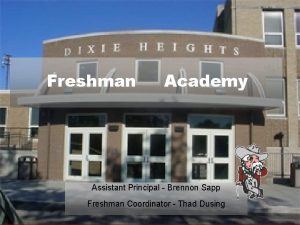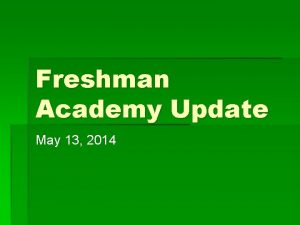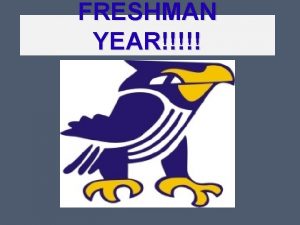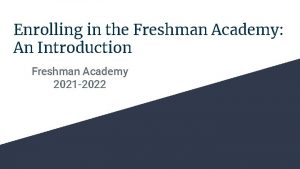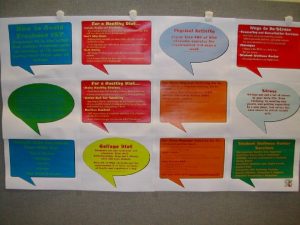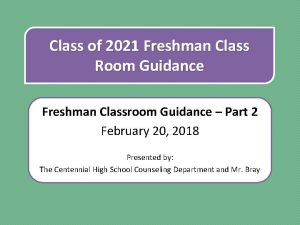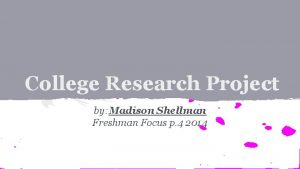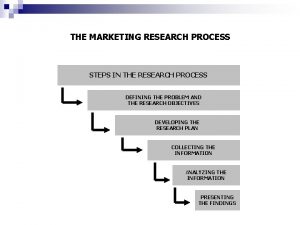Freshman Research Project Steps in the Process Research































- Slides: 31

Freshman Research Project

Steps in the Process Research and Note Taking Thesis Development Outlining First Draft Works Cited Page Second Draft Multimedia Presentation Final Draft

Library Preparations • Have student ID card to use computer, check out books, etc. • Bring change for photocopier (you will need articles, book excerpts, etc. to highlight in class next week). • Bring a hard disk or flashdrive. • Find at least five sources (see overview) • At least 5 3 X 5 cards to complete source information. • Know your email address.

Library Prep (Cont) • Source Gathering Template • Books: Author last, First name. Title. City of Publication: Publisher, Year. Pages. “Topic. ” Title. City: Publisher, Year. Pages. • Electronic Sources: Author last, First name. “Topic or Title. ” Title of Database. Distributor. Place of access. Date of Access. <URL-the entire web address needs to all be on one line>

Library Prep (Cont) • Source Gathering Template Try to cite an archival version if one exists. • A Television: “Title of Segment. ” Title of Program. Channel. Date. Medium. Source. Media. Publication Information. Length. Example “The Threat of Commercial Fishing. ” Earth Matters. CNN. 18 Jan. 1998. Transcript. Broadcast News. CD-ROM. Primary Source Media. Jan. 1998. 22 screens. • Radio Program: Commentator. “Title of Segment. ” Channel. Publisher, City. Date of broadcast. Medium. Date of access. <URL> Example Komando, Kim. “Password Security. ” WCBS News Radio. WCBS, New York. 20 May 2002. Transcript. 23 May 2002. <http: //wcbs 880. com/komando/Story. Folder/story_12>

Research and Note-Taking • • • Highlighted Articles Source Cards Note Cards Source Pages Topic Pages Other

Source Cards • On 3 X 5 Cards • Source Code • Bibliographic Information – – – Author (Last Name, First) Title City of Publication Publisher Year of Publication Page Numbers • Note to Self (Bryant 104) 1 Bryant, Jean. Anybody Can Speak. New York: Barnes and Nobel Press, 2005. 102 -106. Note: Good information on language development.

• Print or Copy Articles or Book Excerpts. 1. At top of article, indicate the source code that corresponds with the article’s source card. 2. Next to the source code, put the form you would use for an internal citation of this source: ( ). 3. Highlight facts that relate to your topic. 4. In margin, note new ideas the points make you think of. This is called annotating. You may want to think of the icons of depth and complexity as you notice important ideas.

25 Notes, You Choose Mode • • Note Cards Source Pages Topic Pages Other Note Taking Strategies

Note Cards • 4 X 6 Cards • Source Code • Note • Quote • Paraphrase • Summary • Page # • Subject Heading 1 Language Creation (37) William Shakespeare doubled the English language by borrowing words From other languages and incorporating them into his writings.

Source Pages Cornell Notes Style Source Code + (parenthetical citation for this source) Subject heading Note from source (citation pg#)

Topic Pages In Cornell Notes Style Subject Heading (citation pg#) Notes from source

Other Note Taking Strategies 25 Notes must have 4 elements: 1. Source Code 2. Actual Note taken from source (Quote, Paraphrase, Summary) 3. Page # (from book, magazine, periodicals). No page # for electronic sources. 4. Subject Heading

Sample Note Categories and Subject Headings • • History of … Referee Talk Childhood Speech Orthographic similarities/differences • Soccer Words • Future of IM • Interlanguage Incorporation • • • Negative Effects Need for IM Gender Popularity Language Switching Speech Delays Non-verbal communication • Developing vernacular • Shakespeare English • Korean Pop Culture

Thesis Development A. • Thesis Statement A thesis statement is a single sentence that formulates both your topic and your point of view. It is your answer to the central question or problem you have raised. – • • Your topic + link to the concept of developing tolerance. Thesis statements help you to see where you are heading and to remain on a productive path as you write. Do not hesistate to revise your thesis statement. You can build on previous drafts.

Thesis Development (cont. ) B. • • Purpose and Audience Answer the following questions: What purpose will you try to achieve in the paper? Do you want to describe something, explain something, argue for a certain point of view, or persuade your reader to think or do something? What audience are you writing for? Is your reader a specialist on the subject? Someone likely to agree or disagree with you? Someone likely to be interested or uninterested in the subject? Your answers to these questions should give your research the appropriate slant or point of view not just in your thesis statement but also in the final outline and the paper itself.

Thesis Development cont. Sample Thesis Statement: Students who wish to write successful research papers must know as much as possible about the modern academic library.

Thesis Development cont. Thesis Formula: Identify person/topic + Why s/he/it is important + link/connect to development of/ contribution to tolerance.

Identify person/topic + Why s/he/it is important + link/connect to development of/ contribution to tolerance. Thesis Templates: ____ is an icon of ____ and had a tremendous impact on _____ fought for _____, and because of that struggle, ____ is possible today. The decline of ____ through ____ has helped create ____ for ____ made a huge impact on ____ by ____, which led to ____.

I. II. Outlining—Specifically for Road to Tolerance Introductory Paragraph with thesis at end. Place, Time and Setting A. B. III. Significant individuals A. B. IV. A significant individual 1. How was s/he involved 2. Why is s/he important Another significant individual Important facts A. B. V. One important fact 1. Explain what it is 2. Explain importance Another important fact Historically significant outcomes A. B. VI. VII. When and where someone was from and died Setting—where event took place One outcome 1. Explain why the outcome is important 2. Explain the effect the outcome had on your person, topic, or issue Another outcome Connection to the concept of tolerance Conclusion with thesis echo *any time you have a 1, you have to have a 2; any time you have an A you have to have a B.

Outlining I. II. Introductory Paragraph with thesis at end. Transition Sentence introducing first section to be covered A. B. C. III. Transition Sentence introducing second section to be covered A. B. C. IV. Topic sentence for paragraph on first sub point. Topic sentence for paragraph on second sub point. Topic sentence for paragraph on third sub point. Transition Sentence introducing third section to be covered A. B. C. V. Topic sentence for paragraph on first sub point. Topic sentence for paragraph on second sub point. Topic sentence for paragraph on third sub point. Conclusion paragraph with thesis echo and stimulating thought *any time you have a 1, you have to have a 2; any time you have an A you have to have a B.

First Draft • Typed in MLA Format q q q q 12 point Times New Roman Font 1 inch margin all the way around Double Spaced throughout Start with name heading on first page, left justified Center title Header with last name and page #, right justified Indent New Paragraphs Internal Citations • Works Cited Page • Submitted to Your Turnitin. com by • Bring a hardcopy to class for revision activities on

Works Cited Page • On the first line of last page of essay document, title: Works Cited Page • Alphabetize your sources • Do not number sources • Double space entries • Include all publication information • Put page numbers used in paper • Include as last page of paper (should be part of your essay document)

Internal Citations • Indicates where the writer got the information used. v. Found within the paper v. Put parentheses ( ) around the citation v. Citations are part of the sentence v. First word listed on Works Cited Page • Examples v. Book (Smith 58) v. Electronic Source/Website (“Romanticism”) v. Interview (Lugo)

Second Draft • Typed in MLA Format q 12 point Times New Roman Font q 1 inch margin all the way around q Double Spaced throughout q Start with name heading on first page, left justified q Center title q Header with last name and page #, right justified q Indent New Paragraphs q Internal Citations • Revised Works Cited Page • Submitted to turnitin. com by

Multimedia Presentation The presentation will be evaluated on 7 categories. 1. 2. 3. 4. 5. 6. 7. Research. Information. Organization. Multidimensional Format. Active Engagement of Audience. Cultural Context. Creativity Presentation outline with job assignments due to the Wiki by

Multimedia Presentation (cont) Preparations: ü Determine parts to be covered and divide responsibilities equitably. . ü Use a variety of visual, aural, and tactile media, such as: handouts, overhead transparencies, video, well-made power point, posters, costumes, a recording of a spoken language, music, food, maps, games, quizzes, etc. ü Organize your presentation logically, and speak clearly and audibly. ü Entertain and inform the audience. ü Rehearse and time your presentation before the performance. ü Presentation Length: 20 minutes ü Presentation Value: 105 points

Presentation Rubric • Research (15 points) v Project was thoroughly researched with information from several sources. • Information (15 points) v Project successfully provides fellow students with new information. v Focus is on new information rather than on those aspects of the topic that the audience might already know. • Organization(15 points) v Information presented in an organized, easy-to-follow manner. v Organizing tools include such aids as handouts, visuals, or a verbal outline as an introduction to the project.

Presentation Rubric • Multidimensional Format(15 points) v Presentation incorporates several ways to disseminate information, including visuals such as posters and costumes, aural devices such as a recording of a spoken language or music, video, food, maps, and so on. • Active Engagement (15 points) v Presenter(s) actively hold audience's attention through a diversely structured presentation. v Presenter(s) work to respond to audience needs during the presentation. • Cultural Context (15 points) v Project successfully incorporates cultural and historical influences and contexts. • Creativity (15 points) v Presenter(s) employ creativity in the report to make the project more interesting, more aesthetically pleasing, humorous, and complete.

Final Draft • Typed in MLA Format q 12 point Times New Roman Font q 1 inch margin all the way around q Double Spaced throughout q Start with name heading on first page, left justified q Center title q Header with last name and page #, right justified q Indent New Paragraphs q Internal Citations • Finalized Works Cited Page • Submitted to turnitin. com by

Library Prep (Cont) • Source Gathering Template • Interview: Last Name, First. Type of Interview. Date. • • • Name of person interviewed. Personal Interview, Telephone Interview, etc. Date: 4 Dec. 2007. • Observation: Last name, First. Type of Observation. Date. • • • Name of person observed. Observation of a child playing with a parent, in a classroom, at a meal, etc. Date: 4 Dec. 2007.
 Argumentative paragraph
Argumentative paragraph Project portfolio management maturity model
Project portfolio management maturity model What are the 7 steps of portfolio process
What are the 7 steps of portfolio process Marketing research process 11 steps
Marketing research process 11 steps How to write an article
How to write an article Stages in the research process
Stages in the research process Steps of business research process with examples
Steps of business research process with examples Process of business research methods
Process of business research methods Research process
Research process 5 steps of qualitative research process
5 steps of qualitative research process Seven steps in research process
Seven steps in research process Ethnography and case study compare
Ethnography and case study compare Combines natural observation with personal interviews
Combines natural observation with personal interviews How to do methodology
How to do methodology Marketing research process 6 steps
Marketing research process 6 steps Bride of the dawn chapter 8
Bride of the dawn chapter 8 Research utilization process steps
Research utilization process steps Tax research process steps
Tax research process steps Bssd powerschool
Bssd powerschool Carmel freshman center
Carmel freshman center Taft freshman academy
Taft freshman academy Freshman zit girl
Freshman zit girl Cps freshman connection
Cps freshman connection Ferguson hall freshman school
Ferguson hall freshman school How do you get mla format on google docs
How do you get mla format on google docs Ucsb freshman orientation
Ucsb freshman orientation Skyward pike
Skyward pike Downingtown west freshman football
Downingtown west freshman football High school freshman orientation agenda
High school freshman orientation agenda Bghs dvusd
Bghs dvusd Northwood high school freshman orientation
Northwood high school freshman orientation Senior freshman junior
Senior freshman junior



